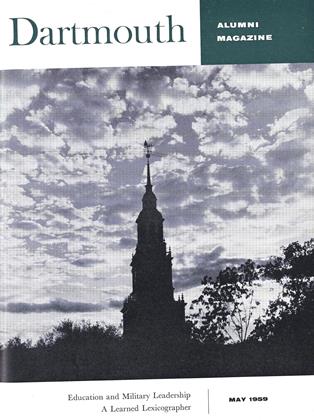A PLAN to have the large garden court of the Hopkins Center serve as a memorial to the Dartmouth men who lost their lives while serving in the armed forces during World War II and the Korean War has been proposed by the College and has met with support from the classes whose members will be memorialized.
The outdoor garden court will be at the center of the group of buildings comprising the Hopkins Center, with the theater adjoining it to the north, the lecture hall to the south, and the studios and snack bar to the west. Open to the New Hampshire sky and landscaped with trees, shrubs and flowers, it will be one of the beauty spots of the Center and will provide a particularly appropriate setting for the memorial. Dartmouth's war dead will be honored in a simple, dignified way, and all their names will be inscribed by classes, possibly on bronze tablets imbedded in New Hampshire granite.
The Dartmouth honor roll for World War II contains the names of 311 men from 33 different classes, and for the Korean War twelve men from nine classes.
The. plans for the Hopkins Center have always included a war memorial aspect, and this was reaffirmed when several classes inquired about memorial possibilities within the Center. The Hopkins Center Building Committee has proposed, however, that the war memorial be a major, combined one, for all Dartmouth classes, rather than a series of small, scattered projects. The Trustees have approved this idea, and also the location of the memorial in the garden court.
The cost of the war memorial will be met by funds raised in the Capital Gifts Campaign, thus eliminating the need of special or separate fund campaigns in the war classes. With construction of the Center beginning next spring, it will be possible also to complete the war memorial project when the Center is completed, instead of negotiating a lot of separate class memorials and delaying them into future years.
The classes with World War II and Korean War dead range all the way from 1902 to 1952. The Classes of 1941 with 36 casualties, 1942 with 34, and 1940 with 31 have the largest numbers of men to be honored by the garden memorial.
A sketch of the memorial garden court, with the stage house of the theatre at the right.
 View Full Issue
View Full Issue
More From This Issue
-
 Feature
FeatureGove (gōv), Philip (fĩl'ìp) B.
May 1959 By JAMES B. FISHER '54 -
 Feature
FeatureDartmouth Study Urges ROTC Program Changes to Meet Nation's Needs
May 1959 By JOHN HURD '21 -
 Feature
FeatureFourteen Gained — Three to Go
May 1959 -
 Article
ArticleTHE FACULTY
May 1959 By HAROLD L. BOND '42 -
 Class Notes
Class Notes1915
May 1959 By PHILIP K. MURDOCK, JAMES LeR. LAFFERTY -
 Article
ArticleTHE UNDERGRADUATE CHAIR
May 1959 By HOWELL D. CHICKERING '59
Features
-
 Cover Story
Cover StoryAbandon All Hope
April 1981 -
 Cover Story
Cover StoryA Century of Photos
Nov/Dec 2005 -
 Feature
FeatureThe Trustees: 15 men and a woman with ultimate authority
October 1979 By Dan Nelson -
 Feature
FeatureMUSIC FESTIVAL
June 1958 By GEORGE O'CONNELL -
 Feature
FeatureQuebec in the Modern World
JULY 1964 By THE HON. JEAN LESAGE, LL.D. -
 Feature
FeatureOrozco And I
MARCH 1991 By Theodore Wachs Jr. '41

